Physical Address
304 North Cardinal St.
Dorchester Center, MA 02124
The number of venous interventions performed by interventional radiology (IR) is increasing. These increasing demands can be broadly divided into those for venous access, and those relating to the management of deep vein thromboses (DVTs). The latter includes the insertion and removal of inferior vena cava (IVC) filters to prevent pulmonary emboli from peripheral DVTs, catheter-directed thrombolysis and primary stenting in acute proximal limb DVTs, as well as interventions for chronic thromboembolic disease. Long-term venous catheters will be our focus. Although the maintenance of arteriovenous fistulas for haemodialysis is of growing importance, it is beyond the scope of this chapter.
Each case should undergo some form of vetting process and pre-procedural assessment.
The referring clinicians must make a hand- or computer-written request, with an appropriate indication, and discuss the case with the IR team. Previous computed tomography (CT), magnetic resonance (MR), ultrasonographic or venographic imaging should be checked. This may alert the operator to considerations such as atypical anatomy, implanted cardiac devices or previous long-term central venous catheters (CVCs). Furthermore, it may reveal whether or not venous access options are limited by venous stenoses, occlusions or thromboses. Avoidance, where possible, of the ipsilateral side of previous breast and axillary nodal surgery can reduce the risk of lymphoedema developing at a later date.
Recent blood results should be assessed to ensure that the coagulation profile, platelet count and haemoglobin levels are within normal limits. Because many venous access procedures are elective, there should be scope to correct any coagulation abnormalities before intervention. The platelet count should exceed 50 × 10 9 /L and, if necessary, a platelet transfusion immediately before and during the procedure should be arranged. Correction of an international normalised ratio (INR) of greater than 1.5 should be undertaken, either with oral or intravenous therapy. The estimated glomerular filtration rate (eGFR) is indicative of renal function. If impaired, contrast medium should be used with caution.
An elevated white blood cell count and other biochemical markers suggestive of infection may delay tunnelled line insertion. The patient should be haemodynamically stable or have the necessary medical or anaesthetic support in place. With a non-urgent case, anticoagulants should be stopped if possible pre-procedure in accordance with local protocol.
Written consent should be taken before the procedure, ideally at least a day pre-procedure. There is an increasing tendency to have outpatient IR clinics and ward-round visits for more complex procedures that may carry significant morbidity or mortality.
Before the procedure, the World Health Organisation (WHO) checklist or other dedicated IR safety checklist should be completed with all members of the IR team present. This identifies any avoidable errors and never-events, such as intervening on the wrong patient or on the wrong side or inducing anaphylaxis to a known allergen. The imaging requirements are a fluoroscopy suite and an ultrasound unit with a high-frequency linear probe (10 to 15 MHz).
The procedure is performed under standard aseptic conditions. A peripheral cannula can be helpful to give intravenous analgesia or sedation. However, in many patients, peripheral venous access will be poor and may be the reason that they have been referred for long-term venous access. Cardiac monitoring and pulse oximetry should be used at all times. The patient is transferred supine on to the fluoroscopy table with the head as close to the end of the table as possible. A pillow can be used to support the head and another pillow could be placed under the knees, for comfort but also to help distend the chest and neck veins, if these are the routes of access. Alternatively, the table can be placed in the reverse-Trendelenburg position, with the head down, to achieve the required venous distension.
Pre-procedure ultrasound imaging enables assessment of the venous anatomy and establishes whether the veins are patent or not. Usually, a right internal jugular vein (RIJV) approach is taken because the RIJV is easily visualised on ultrasound, can be manually compressed in the event of bleeding and leads most directly to the junction of the right atrium and superior vena cava. Alternatives include the left internal jugular vein (LIJV), both external jugular veins, the less easily compressible subclavian veins and other access vein options that will be discussed later.
The available instruments should include a standard sterile vascular procedure pack and possibly a minor surgical cut-down set, including straight and curved scissors, haemostatic forceps, toothed forceps and a needle driver.
Long-term CVCs have a major role in enabling the administration of numerous medical therapies in modern hospital settings. They are often used to deliver irritant chemotherapeutics in oncology units, as well as for haemodialysis in end-stage renal failure.
CVCs are inserted directly into a central vein. If taking a longer route via a peripheral vein, they are referred to as peripherally inserted central catheters (PICCs). Polyurethane CVCs are generally removed or exchanged after 7 days within our centre, to reduce the risks of infection and thrombosis, as well as for patient comfort. Long-term CVCs, which are silicone based, are tunnelled, usually into the anterior chest wall, for improved patient comfort and to reduce infection rates.
Over recent decades, ultrasound and fluoroscopy have become more readily available. These techniques facilitate safe and accurate, image-guided placement of central venous catheters, thus forming a significant portion of the IR workload. In the United Kingdom, certainly in our centre, the trend for this began in the late 1980s. There is also an argument that with tighter surgical operating room schedules, IR venous access procedures are more efficient and cost effective.
The patient's skin should be cleaned with a sterile detergent solution from the ipsilateral hairline posteriorly, the angle of the mandible superiorly, the midline neck to the manubriosternal angle anteromedially and across to the lateral border of the ipsilateral pectoralis major. The skin should then be covered, usually with a large, rectangular fenestrated drape. The top of the fenestration sits 2 to 3 cm above the medial aspect of the right clavicle and extends inferolaterally below the clavicle by 8 to 10 cm.
Under direct ultrasound guidance, local anaesthetic, usually 10 mL of 1% lidocaine, is infiltrated into the skin and subcutaneous tissues of the neck, down to the level of the internal jugular vein (IJV). Local anaesthetic is also infiltrated into the anterior chest wall along the predicted tract of the tunnel, from the catheter insertion point, heading cranially to reach the clavicle. In the time taken for the local anaesthetic to become effective, the catheter pack is opened and both lumens are flushed and locked with heparinised saline (0.9% sodium chloride with 1000 IU of heparin). Care should be taken at this point to avoid touching the catheter.
A 5- to 10-mm horizontal incision is made superficial and lateral to the IJV and blunt dissection performed with curved scissors or the needle driver. Ultrasound-guided puncture is performed via the incision with a standard 18-gauge one-part needle. It is important to ensure that the tip of the needle is always visible on ultrasound to reduce the risk of inadvertent arterial puncture or breaching the pleural cavity. A 5-mL syringe with a small volume of saline is fitted to the back of the needle, and when RIJV puncture has been performed, aspirating the syringe confirms correct needle placement. It is important to puncture the vein as close as possible to the clavicle, to keep the parabola of the catheter wide, smooth and without a kink, once it has been taken through the subcutaneous tunnel. Furthermore, a better curve forms with a lateral IJV puncture, using an in-plane needle approach, as opposed to an anterior or transverse puncture, using an out-of-plane approach.
Once the RIJV has been punctured, an 0.035-inch J -wire is inserted. When the wire has been inserted successfully, fluoroscopy is used to guide it through the right atrium and into the IVC. A 5-F catheter with an angled tip may help to direct the wire into the IVC, if necessary ( Fig. 86.1 ).
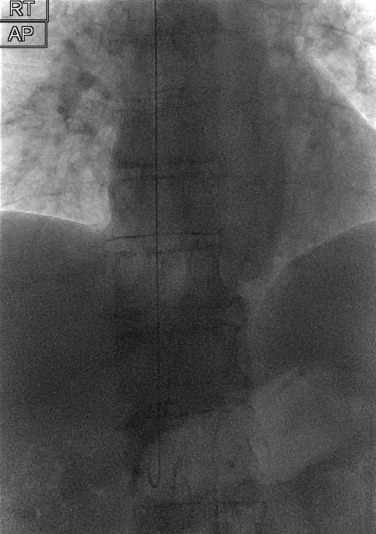
In female or overweight patients, keeping the chest wall tunnel as medial or lateral as possible, in the infraclavicular fossa, may stop breast tissue pulling the catheter out when standing. However, exiting the line more laterally, in line with an axillary fold, is more cosmetically pleasing; upon removal of the line, the scar is often better hidden.
An 8- to 10-mm incision is made at the point that the catheter is to exit from the subcutaneous tunnel. The end of the catheter is attached to the metal or plastic tunnelling device by means of a screw thread at the bottom of the tunneller, and the tunneller and line are pushed through the subcutaneous tissue to exit at the neck incision site. The tunneller and catheter are then pulled through the neck incision completely until the cuff of the catheter lies well within the chest wall tunnel. This should be 3 to 5 cm from the entry point but sufficiently below the clavicle for comfort. Once the catheter is through the tunnel, it should be laid over the patient's chest, aiming to reproduce the path it will follow inside the patient. Fluoroscopic screening is used to assess where it needs to be cut; the tip should be left near the atriocaval junction—usually 2 to 3 cm below the carina, or just beyond the level of the inferior border of the right main bronchus. The catheter is cut to an appropriate length using scissors (haemodialysis catheters do not need to be cut).
The catheter is inserted into the RIJV through a peel-away sheath. Once the catheter is in place and the peel-away sheath removed, the lumen(s) can be aspirated, then flushed and locked with heparinised saline. Fluoroscopy is used to confirm the position of the catheter. Absorbable sutures are used to close the neck incision, and an interrupted 2-0 silk suture on the anterior chest wall at the catheter insertion site is tied to the catheter to anchor it. The cuff within the tunnel induces an inflammatory response and scarring that helps to keep the catheter firmly in place. Occlusive dressings are applied to the venotomy site in the neck and the catheter exit site on the chest.
Many long-term CVCs are now compatible with the rapid injections required for CT examinations. This information can be found in the product specifications and should ideally be documented in the report or patient notes for future reference ( Summary Box ).
Hand washing
Sterile gown and gloves
Surface disinfection, with air-drying
Sterile barrier drapes
Preference for upper extremity access
Appropriate anchorage of catheter and dressings
Removal at the earliest opportunity.
The modified catheter tip of a Groshong catheter (Bard Access Systems, Salt Lake City, UT, USA) houses a three-way valve that is closed at neutral pressure but opens outwards during infusion and inwards during aspiration. The purported benefit of this device is to minimise catheter thrombosis and fibrin sheath formation. In principle, it is very similar to Hickman line insertion, except for a few important technical differences.
The catheter is always inserted via the subclavian vein, at the junction of the outer and middle thirds of the clavicle. The vein is punctured with a micropuncture needle, and an 0.018-inch wire is introduced into the IVC. After a long peel-away sheath has been inserted over the wire, the inner dilator and wire are removed, and the catheter is inserted. The catheter tip position is adjusted under fluoroscopy, and the peel-away sheath is removed. After infiltrating local anaesthetic into the skin of the ipsilateral chest wall, reverse tunnelling is performed to an inferomedial position. The cuff is left under the skin surface, and the hub is attached and secured before the skin incisions are closed, again with a 2-0 silk suture.
Totally implantable vascular access devices (TIVADs) also known as ports, consist of a well with a self-sealing septum, usually all housed within a titanium cover, attached to a silicone catheter. Dual septum/lumen ports are also readily available, but these are large. The port is placed subcutaneously and is accessed via specially designed non-coring Huber needles inserted through the skin surface into the septum. There is growing evidence to suggest that there are relatively higher infection rates in Hickman lines, probably because of the closed nature of ports to the outside world. In addition, ports are more discrete and allow the patient to perform certain activities unimpeded, such as swimming or bathing ( Figs 86.2 to 86.5 ).
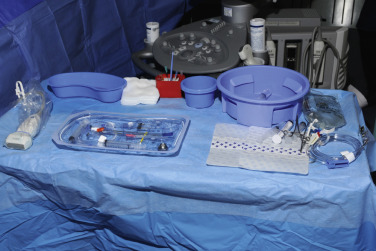
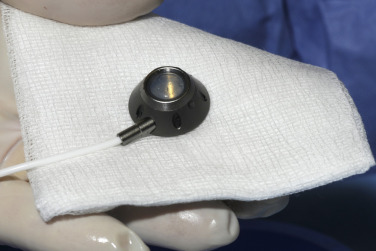
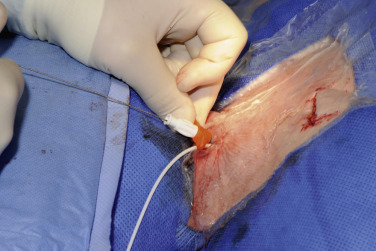
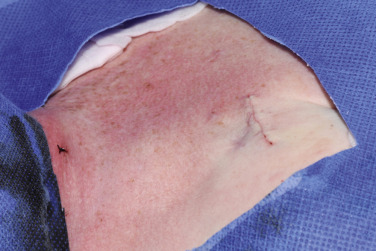
The anterior chest wall is the favoured position for the port at our centre. However, ports are also regularly placed more inferolaterally in the chest wall, as well as within the medial aspect of the upper arm. It is important to try to avoid placement within a potential radiotherapy field because this can impair wound healing.
The insertion technique is the same as that of a Hickman line, but with the added step of making a subcutaneous pocket for placement of the port. The port site is infiltrated with 20 mL of 1% lidocaine/1 : 100,000 adrenaline. For aesthetics, an incision of 4 to 5 cm can be made in line with, but slightly medial to, an axillary fold. The subdermal layer of the incision and a pocket more superomedial should be dissected bluntly with haemostatic forceps. If one of the rounded finger grips of the handle of the forceps can fit through the incision into the pocket, this is usually enough for a snug fit for the port. If there is a lot of breast tissue, a more anterior pocket sitting over the clavipectoral fascia provides better rear support when trying to access the port with the Huber needle and reduces the risk of the port flipping—whereby the septum does not face the skin properly.
The port is then connected to the catheter and the tunnel tool, and a tunnel is made towards the neck incision. The tip of the catheter is then positioned at the atriocaval junction, under fluoroscopy, using a peel-away sheath. Two to three 2-0 Vicryl deep dermal sutures are bought in apposition over the port before a 4-0 continuous subcuticular Monocryl suture is applied and closed with an Aberdeen knot and dressed. Dermal glue can be used instead of, or in addition to, the subcuticular suture for closure. It has the added benefit of instantly waterproofing the incision and creating another barrier to infection. Fluoroscopy is used to document the final position of the catheter ( Fig. 86.6 ). The port is then locked with heparin, and a locked Huber needle can be left in situ should chemotherapy need to commence within a few days.
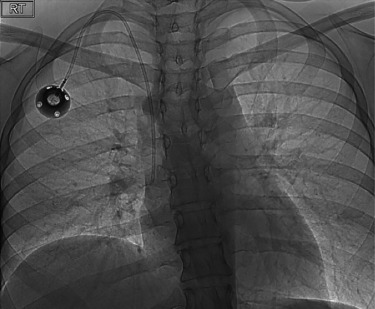
Surgically formed arteriovenous fistulas or grafts are the preferred form of haemodialysis access in renal failure. Indeed, the 2006 Kidney Disease Outcomes Quality Initiative (KDOQI) Clinical Practice Guidelines for Vascular Access in Haemodialysis states that short- and long-term tunnelled dialysis catheters should be avoided, if possible, and that arteriovenous fistulas and grafts are preferable. The 2012 update promotes the use of the HeRO (Haemodialysis Reliable Outflow) graft (Merit Medial Systems, UT, USA).
For a certain subset of patients with bilateral central venous stenosis (thereby preventing successful surgical use of peripheral native veins), good cardiac output and a good-quality brachial artery, the HeRO graft can be inserted using a joint IR and surgical procedure. Essentially, a nitinol-enforced silicon catheter is inserted via the IJV by an interventional radiologist and tunnelled as far as the ipsilateral deltopectoral groove. A polytetrafluoroethylene (PTFE) graft is anastomosed to the brachial artery by the surgeons and brought up to the deltopectoral groove, where it is connected to the venous component using a specially designed titanium connector. The PTFE graft is then ready to be punctured and used for haemodialysis, with no waiting time required for maturation.
Pure endovascular creation of arteriovenous fistulas has recently gained interest. For example, the everlinQ endoAVF system (TVA Medical, TX, USA) involves retrograde sheath insertion into the brachial artery and the adjacent brachial vein. Magnetised catheters are inserted and aligned appropriately, so that they hold the artery and vein together in parallel. A small radiofrequency electrode is deployed and activated, creating a fistula between the artery and vein. The catheters are removed, and arterial blood now flows into the vein. One seemingly inherent downside to this is that embolisation of the downstream brachial vein(s) is required to shunt the blood into the superficial venous system. Long-term outcomes of these systems are still being evaluated, and there is little consensus on their use at present.
However, old-fashioned tunnelled catheters still have a role for dialysis patients. Tunnelled dialysis catheters are used if all other points of access have been exhausted, if the surgical fistula is still maturing or has failed. Insertion techniques in comparison to other tunnelled lines are virtually identical.
Catheter tips are usually placed a bit deeper within the right atrium to achieve higher flow rates for dialysis. If Tesio lines (Medical Components, Harleysville, PA, USA) are being used, two separate catheters are inserted and tunnelled. This is often done using two separate punctures, greater than 1 cm apart, to prevent bleeding due the guttering phenomenon that is encountered when two lines are inserted via one puncture site. The purported advantage of these lines is that increased movement between the two catheter tips reduces fibrin sheath and thrombus formation. Furthermore, pre-insertion venography may reveal central venous stenoses that require prior balloon venoplasty. The lines are essentially fixed in length centrally, with LIJV lines usually measuring 32 cm (instead of 28 cm) because there is a longer path to reach the superior vena cava (SVC).
When the normal routes of access have been exhausted, secondary to scarring and thrombosis, unconventional routes may be needed. Tunnelled catheters can be inserted into femoral veins, but there is an increased risk of catheter-related infection. Some of the approaches include using lumbar or hepatic veins to reach the IVC.
Become a Clinical Tree membership for Full access and enjoy Unlimited articles
If you are a member. Log in here